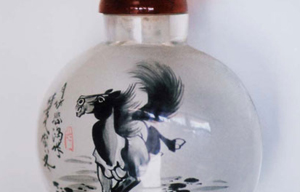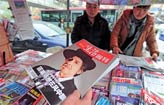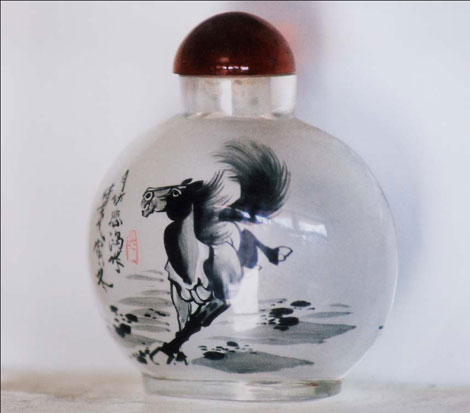The snuff of dreams
Updated: 2011-09-16 08:54
By Yan Yiqi (China Daily)
|
|
Chinese collectors have discovered the value of beautiful bottles
Snuff is a peppery tobacco that when sniffed delivers a short nicotine hit. Popular centuries ago, especially in Europe, it was carried in leather pouches but when it became popular among the Chinese elite, beautifully painted bottles were crafted to hold the substance.
And now thanks to rich Chinese investors, these bottles are delivering a big hit to the antique industry.
Although the snuff-snorting habit disappeared about 200 years ago, collectors of Chinese snuff bottles have always been around.
Last year Hong Kong auction house Bonhams sold Mary and George Bloch's famous snuff bottle collection, and the price paid set the antique industry buzzing.
When the auctioneer's final hammer fell, more than HK$54 million ($6.9 million) had been splurged on the 155 pieces.
Some of the rarer pieces reached prices four times higher than expected.
It was later revealed that a Beijing real estate developer was one of the biggest bidders.
Hei Guanyu, chairman of China Snuff Bottle Society, says these unique vessels worked their way into Chinese culture.
"Among these mediums, enamel and glass have caught the most attention from international collectors," he says.
Snuff is a product made from ground or pulverized tobacco leaves. It originated in the Americas and was commonly used in Europe by the 17th century.
The Italian and French missionaries came to China in the late 16th century, carrying snuff in boxes.
As snuff in such boxes were easily affected by moisture and became stale, the imperial workshops of Qing Dynasty (1644-1911) started to improve the small bottles used to contain traditional Chinese medicine pills to hold snuff.
As early as the 17th century, Westerners became keen collectors of Chinese snuff bottles because they were small, easy to carry and were exquisitely crafted.
Collectors at that time especially loved snuff bottles that were produced by imperial workshops.
During the late 18th century to the early 19th century, when China was under social unrest, large shipments of snuff bottles were brought abroad.
Hugh Moss, a British snuff bottle collector, says he fell in love with these small bottles at first sight.
"I first discovered the art form when I went to work at my father's antique shop in London and found one small cabinet full of snuff bottles. I was drawn to them immediately," he says.
Moss has been collecting snuff bottles for more than 50 years and is one of the most distinguished collectors in the industry.
He has built a website to share the latest news and auction information about Chinese snuff bottles and wants to share his passion for both ancient and modern snuff bottles.
Moss is not the only example of how foreigners are interested in this Chinese antique.
In 1968, Edward Choate O'Dell, a US snuff bottle collector, established the first Chinese snuff bottle society.
It was the first society to inform snuff bottle collectors with scholarly articles about bottles. The organization later became the International Chinese Snuff Bottle Society.
Berthe H. Ford, president-elect of the society, says the petite size of these vessels make them special.
"These items are small and are a microcosm of Chinese art. People who love Chinese art are delighted to have small objects that echo all of Chinese art," Ford says.
She believes the interest in snuff bottles will increase as tourists see many interesting modern bottles in the East and the West.
For a long time, the collection and auction centers of Chinese snuff bottles have been European and US cities.
Hei agrees that the small bottles can make big changes.
"Before the 21st century, New York, San Francisco, Paris, Berlin and London were international centers of Chinese snuff bottle collection," he says.
"Even today, although the Chinese auction market is developing fast, snuff bottles are still one category that is easily neglected. It is a very special phenomenon that the bottles were made by Chinese artists but get high recognition in European and US markets."
With the auction center of snuff bottles moving to Hong Kong, an increasing number of Chinese collectors have started to focus on this art form.
"Looking from the snuff bottle auctions in 2010, we can tell that Chinese collectors have turned their eyes on this category," says Julian King, head of Chinese Ceramics and Works of Art at Bonhams Hong Kong.
He says the record-breaking bid for the snuff bottle was by a real estate businessman from Beijing.
"Chinese collectors are willing to bring the art works back to China, and with their high consuming capacity, they will be more often seen in upcoming auctions," King says.
According to King, compared with foreign collectors, Chinese collectors tend to bid on snuff bottles at higher prices.
In last year's November auction at Bonhams Hong Kong, Chinese collectors accounted for 52 percent of business volume, but bought only 20 percent of the items up for auction.
Moss is also aware of such change.
"There is a great change in the snuff bottle market, for emerging collectors who are more willing to purchase bottles of high quality with high price cannot wait to participate," he says.
In recent years, snuff bottles have become new auction house darlings not only in Hong Kong, but also in Beijing and Tianjin.
Successful bids of more than 1 million yuan ($156,500) appear nearly every year.
"Chinese collectors are becoming crazy about bidding for traditional art works these years, but there are some of them who really understand art but have limited money," King says.
"Large and expensive vases and furniture are not suitable for them. Small and affordable art pieces like snuff bottles become their favorite."
King believes with the increasing domestic attention on snuff bottles, more people will join the group of snuff bottle collection in China.
"The prices of exquisite and antique snuff bottles are rising, and so are the prices of common ones. It is for sure that the collection and auction center of this art work will come back to China," he says.
E-paper

The snuff of dreams
Chinese collectors have discovered the value of beautiful bottles
Fast forward to digital age
Bonds that tie China. UK
From death matches to child's play
Specials

Singing success
Western musicians bring much-needed impetus to live performance industry

Salary bonanza for bosses
Top boss gets 8.78 million euros a year, far more than the State enterprise CEO with highest pay

Kicking for joy
Swedish college student represents China in Taekwondo championships

